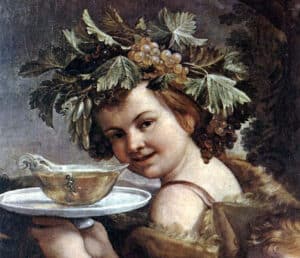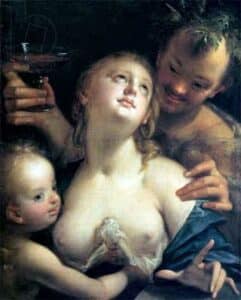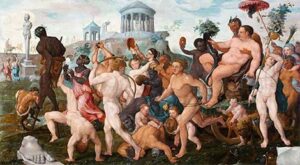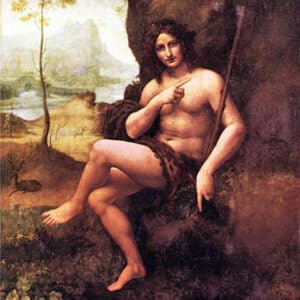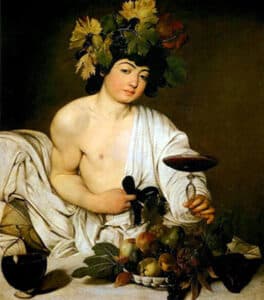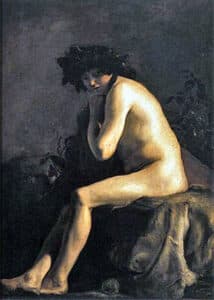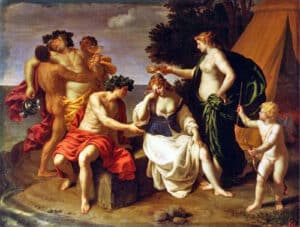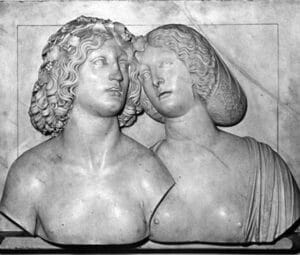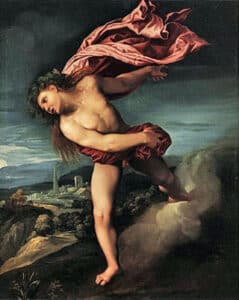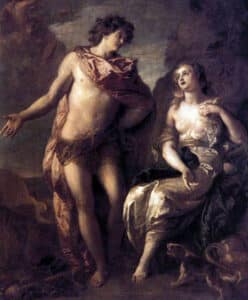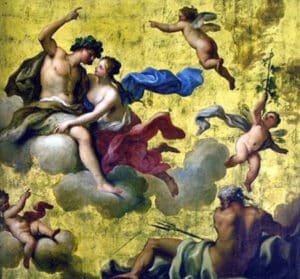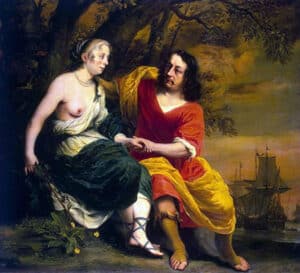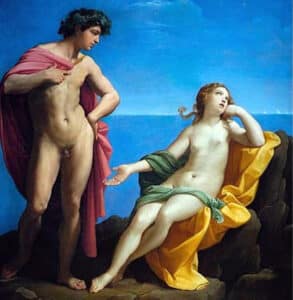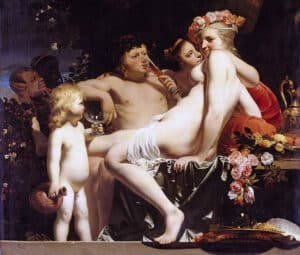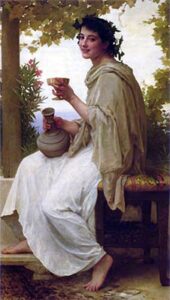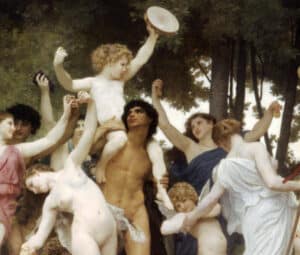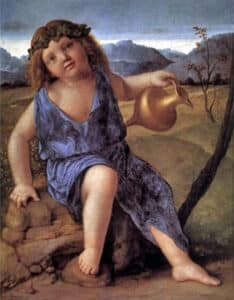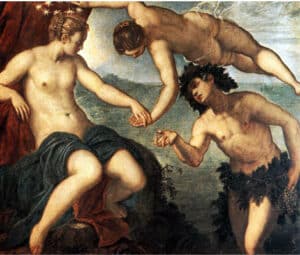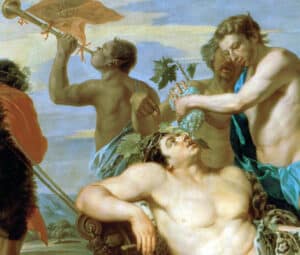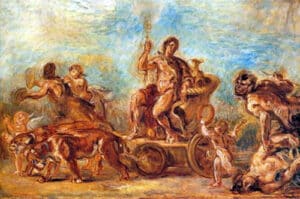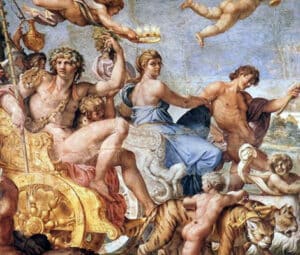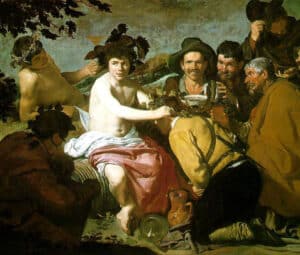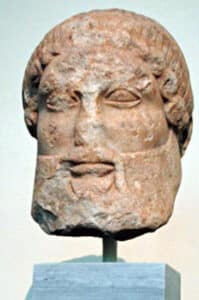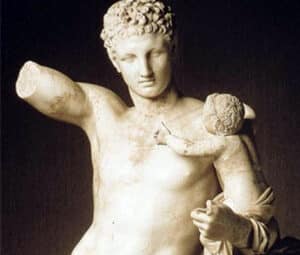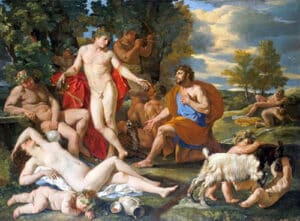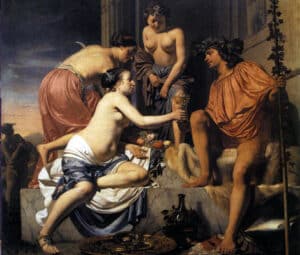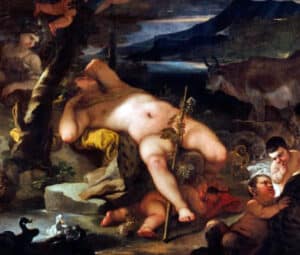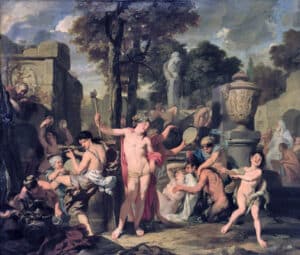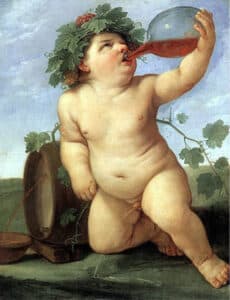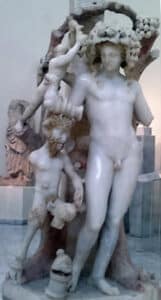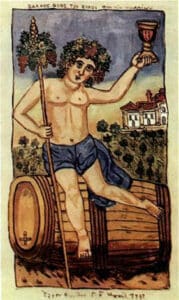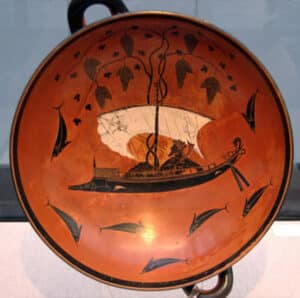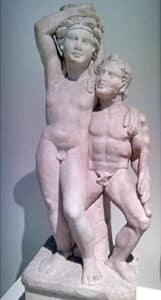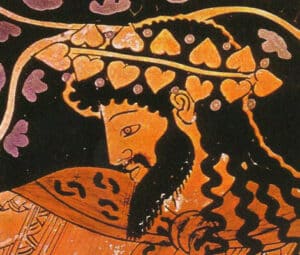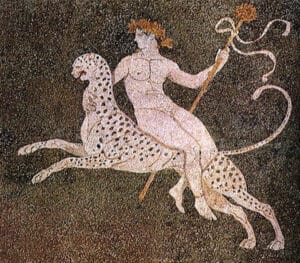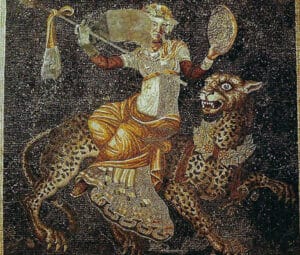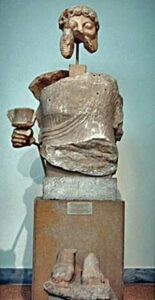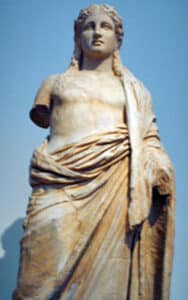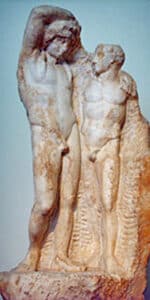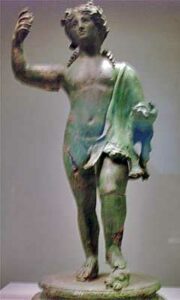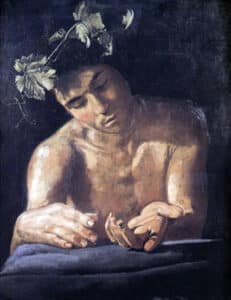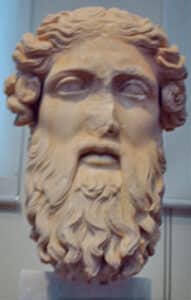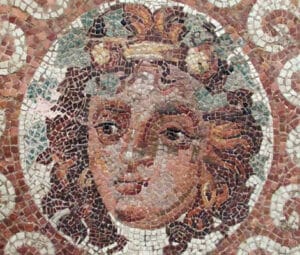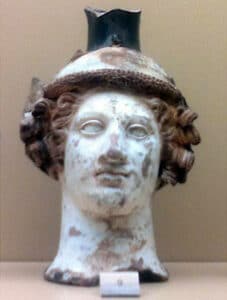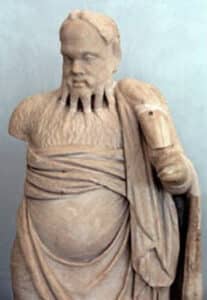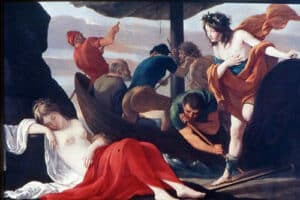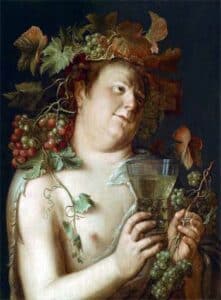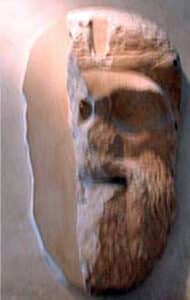Dionysus was the Olympian god of Wine and Grape Harvest, Festivals and Merriment, Divine Ecstasy and Frenzy, and the Theater. He was linked to all manner of pleasure and debauchery. His sacred emblems include the thyrsus, grapevine and ivy, theatrical masks, the bull, panther, goat, serpent, and, of course, the phallic symbol.
Dionysus did not always reside with the other gods and goddesses on Mount Olympus. He would constantly travel the world with his followers, the Satyrs and the Nymphs, Guardians of Nature.
Key Facts
Family tree
| Parents | Zeus and Semele |
| Partner(s) | Ariadne, Althaea, Ampelus, Aphrodite, Aura, Beroe, Erigone, Nicaea, Pallene, Polymnus |
| Siblings | Aphrodite, Apollo, Ares, the god of war, Artemis, The Great Huntress, Athena, the goddess of wisdom, Hermes, God of All Trades, Hephaestus, the god of blacksmiths, Aeacus, Angelos, Eileithyia, Enyo, the goddess of war, Eris, Ersa, Hebe, Helen, The Most Beautiful Woman In The World, Heracles, The Strongest Hero, Minos, Pandia, Persephone, The Enigmatic Queen of the Underworld, Perseus, The Legendary Slayer of Medusa, Rhadamanthus, the Charites (Graces), The epitome of charm and beauty, the Horae, the Litae, the Muses, The Divine Inspirations Behind Art, Science, and Culture, the Moirai, Spinners of The Thread of Life |
| Offspring | Immortal: Charites, Hymenaeus, Iacchus, Methe, Pasithea, Priapus, Often considered a Satyr, Sabazius, Telete, Thysa Mortal: Ceramus, Deianeira, Eurymedon, Maron, Narcaeus, Oenopion, Peparethus, Phanos, Phliasos, Staphylos, Thoas |
Names & Others
| Roman Name | Bacchus |
| Other Names | Liber |
| Ancient Greek | Διόνυσος |
| The God of | Wine, Grape Harvest, Fertility, Festivities, Merriment, Ritualistic Madness, Religious Ecstasy, Vegetation, Orchards, Theater |
| Symbols | Thyrsus, Grapevine, Ivy Crown, Bull, Lion, Panther, Snake, Goat, Theatrical Masks, Phallus |
Name and Etymology
The name Dionysos is attested as such from the Mycenaean Greek. The first written form in Linear B is di-wo-nu-so. The name is comprised of two parts: dio- and –nysos. The first part, dio, is associated with Zeus since antiquity.
However, the second part is less clear. The term “-nysos” has no documented origin. The name can be interpreted in the following ways:
- It is linked to Nysa, the mountain where the god was born and nursed by the nymphs Nysiads.
- Nysos could be a masculine form of the Thracian term νύση (nuse), which signifies the nymph. This suggestion further extends to the name signifying “the son of Zeus”.
- It could be a nickname referring to “young Zeus”.
The Egyptians associated him with Osiris, in the sense of the patronage of agriculture and fertility. However, Osiris had nothing to do with the sacral ecstasy. In the same way, Freyr is the Norse equivalent of Dionysus, as the ruler of fertility. Another association is with Odr, an Old Norse deity linked with the divine madness.
The Egyptians identified him with Osiris in terms of agricultural and fertility patronage. Osiris, however, had nothing to do with the sacral ecstasy. As the ruler of fertility, Freyr is the Norse counterpart of Dionysus. Another connection is with Odr, a deity associated with divine madness.
Dionysus’ Epithets
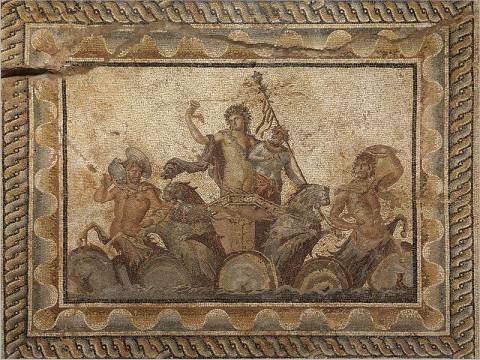
Many epithets were used to describe the god and his different roles and responsibilities. Some of his most well-known epithets were:
- Adoneus, a latinized form of the name Adonis, a mortal of unparalleled beauty
- Androgynos, signifying the god’s double nature, both male and female
- Bromios, in reference to his transformation into bull and lion
- Dimetor, the one who was born twice
- Eleutherios, the liberator
- Nysios, from Nysa, his birthplace
- Semeleios, the son of Semele
The god also absorbs – together with Zeus – the role of Sabazios, the father figure of the Thracian and Phrygian pantheon.
God of Wine
Some epithets were used to show his role as the god of wine, like Acratophorus (“giver of pure, unmixed wine”), Lenaius (“of the wine-press”), Morychus (“smeared with wine leaves”), Oeneus (“wine-dark”), Skyllitas (“of the vine-branch”), Theoinus (“god of the wine”).
God of the Mysteries
Many of his epithets have to do with his role at the mysteries. For instance, Bassareus, Bougenes, Liknetes, Mystes (“of the mysteries”). There was also Dithyrambos, which was used at his festivals to signify a specific type of hymn. And of course, the most famous epithet, Iacchus, linking to the hymn written for him.
God of Vegetation
Another set of epithets is used to demonstrate his connection to vegetable and fruits. Some of them are Cistophorus (“bearer of baskets” or “bearer of ivies”), Cthonius (“of the earth”), Dendrites (“of the trees”), Endendros (“in the tree”), Phleus (“related to the bloom of a plant”), Sykites (“of the figs”), and Thyllophorus (“the one who bears leaves”).
Dionysus’ Origins and Family
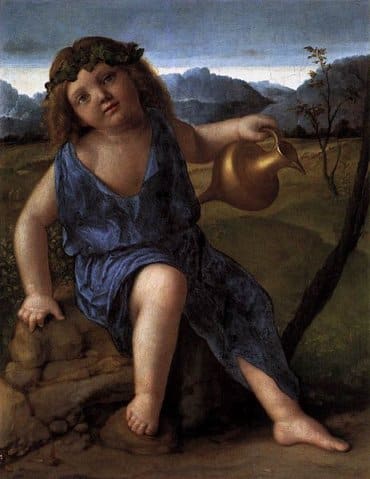
Dionysus’ origin tale is fascinating because he is the only Olympian to have a mortal mother! He was infact the mortal offspring of Zeus and Semele. Semele was a Theban lady. Zeus crept into her chamber one night and slept with her, unseen by the human eye. She had no idea who it was, but she felt his heavenly presence.
Of course, Semele did not conceal what had occurred, nor her pregnancy. When Hera discovered what had happened, she instantly suspected her husband. Jealousy drove her to devise a plan to exact revenge on Semele; she disguised herself and persuaded the princess to force her lover to disclose his true divine form.
Everything was fine up until this point. However, no mortal can endure seeing the true form of a God, which Semele was unaware of.
When Zeus arrived to see her, she made him swear to grant her a wish of her choosing. Zeus, who was passionately in love with her, agreed to her request. He even swore on the name of the river Styx, The Goddess of the Underworld River that he would do whatever she asked.
Semele expressed her desire to see his real form. Zeus was desperate; he knew what would happen, but he had no option because he was bound by oath. He disclosed to the princess his true nature. Semele died instantly by burning to a crisp.
Despite this, Zeus had not lost everything. He was able to save the fetal Dionysus and sew him to his thigh. He then gave birth to his son while also bestowing immortality on him, which he would not have received otherwise, being born of a mortal mother.
Dionysus in Nysa
The misfit God was brought to Mount Nysa shortly after his birth. Silenus the Satyr and Nysies the rain nymphs raised him there. Silenus instructed him and showed him how to cultivate grapes. Dionysus went it a step further by being the first to create wine.
For many years, he traveled throughout Asia, particularly India, and was taught the process of winemaking. This lengthy but fruitful journey was followed by his ascension to Olympus. He was the last Olympian to ascend the mountain.
Dionysus’ Lovers
Dionysus was the face of sexual liberation. Among the famous ritualistic orgies and his hedonistic way of living, Dionysus was actually married! He also had a couple of minor relationships, not as many as other gods and goddesses, but still worth mentioning.
Dionysus and Ariadne
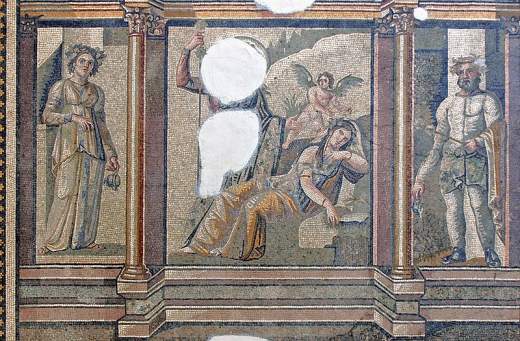
There are several stories about how Ariadne came to be Dionysus’ bride. The most common version holds that the god discovered Ariadne abandoned on the island of Naxos. But how did that happen?
Ariadne was King Minos of Crete’s daughter. She helped the Athenian hero Theseus kill the Minotaur, a half-man, half-bull monster. The princess then escaped to Athens on Theseus’ ship. However, while Ariadne was asleep, Theseus, The Founding Hero Of Athens abandoned her to Naxos.
Dionysus discovered the princess and fell in love with her right away. They got married and lived blissfully ever after. She also ascended to Olympus and became an immortal.
Another version of the tale has Ariadne being discovered by the god many generations before. When Bacchus went to battle with the people of Argos, Perseus either killed or turned Ariadne to stone. The deity of wine then descended to the underworld, rescued Ariadne, and brought her to Olympus with him.
They had a number of children, including Oenopion and Staphylus, who were linked with wine and grapes, respectively.
Immortal Loves
Dionysus was one of the gods who had few love relationships. He had brief relationships with the goddesses Cronois and Nicaea. He also wooed Beroe, but he lost her to his uncle, Poseidon.
The tales about Aphrodite and Aura are more intriguing.
Aphrodite had once an affair with Dionysus, and she got pregnant. Hera, wanting to punish her for her promiscuity, cursed the fetus in her belly. Thus, Priapos was born, a dwarvish god with an oversized phallic member. Others, however, believe that Priapos was the offspring of Zeus and Aphrodite.
The titaness Aura was the goddess of the breeze. Dionysus got her drunk and slept with her without her consent. When Aura woke up and realized what had happened, she was infuriated with the God. She had twin sons and ate the first child out of rage. The second child was saved by the gods. That young man was Iacchus, the well-known Eleusinian God.
Mortal Loves
The promiscuous god also wooed a few mortals. His love affairs with mortal women include:
- Althaea, a queen of Calydon. Dionysus loved her and took her husband’s permission to seduce her. In return, the god gifted king Oineus the grapevine.
- Erigone, a maiden from Attica. The god used false grapes to seduce her.
- Pallene, a Thracian princess. Her father held wrestling matches and the winner would marry the princess. Dionysus won the contest and wedded Pallene.
- Physcoa, a votary of the god.
Dionysus’ affairs with two mortal males, on the other hand, were far more interesting. Ampelos, a lovely adolescent Satyr, was the first of the two. He was adored by the deity. When Ampelos attempted to ride a wild bull, he was slain as a punishment from Selene, the goddess of the moon. Dionysus transformed his body into the first grapevine.
Ovid tells a different version of the same tale. Ampelos appears to have died while attempting to pick grapes from a high branch. Bacchus then rewarded the young boy by transforming him into a brilliant star in the constellation Vindemitor, which is now known as Bootes.
The other young man was Polymnos (also known as Hyplipnus). When Dionysus wanted to visit the Underworld to bring back Semele, his mother, Polymnos showed him the way. He asked for one thing: that the god would sleep with him.
Dionysus took an oath and set on his journey. However, when he returned, he discovered that Polymnos had perished. To keep his pledge, he cut a branch of a tree and shaped it into a phallic shape. The god then used the branch to demonstrate that he had kept his pledge to Polymnos. To honor this desire, phallic-shaped objects were frequently used in mysteries honoring the deity.
Dionysus’ Offspring
Dionysus had fewer offspring than the other gods. However, they all had one thing in common: they were the founders of wine-producing areas.
Immortal Children
Dionysus did not have many immortal children. The most well-known ones are:
- Iacchus, a god of the Eleusinian Mysteries. He was the son of Dionysus and either Aura or Aphrodite.
- Methe, the nymph-goddess of intoxication and drunkenness.
- Pasithea, goddess of rest and relaxation.
- Priapos, the god of garden fertility.
- Telete, the goddess of the initiation of the Bacchic Mysteries.
- Thysa, the nymph-goddess of the Bacchic ritualistic frenzy
Other children attributed to Dionysus are Hymenaeus (most commonly Apollo’s son), the Charites (most commonly Zeus’ daughter), and Sabazius. Sabazius was a Thracian god of vegetation and wine, who was either identified with Dionysus or perceived as his son.
Mortal Children
Most of Dionysus’ mortal children were sons of Ariadne. In detail, Dionysus and Ariadne gave born to:
- Ceramus, a lord in Kerameikos district in the center of Athens, where ceramics were made
- Eurymedon, lord of Sicyon and one of the Argonauts
- Oenopion, a king of the island of Chios and personification of the wine
- Peparethus, a king of the island of Peparethos (now Skopelos)
- Phanos, a lord of the island of Thasos and one of the Argonauts
- Phlias (or Phliasos), a lord of Sicyonia and one of the Argonauts
- Staphylus, a king of Caria and one of the Argonauts, as well as the personification of the grape
- Thoas, a king of the island of Lemnos
He also had other mortal children. Some of them were:
- Dianeira, a daughter of Althaia. She was a princess in Calydon and the third wife of Heracles – the one who also killed him.
- Maron, a priest in the region of Cicones. He supplied Odysseus, The Cunning Hero Of The Trojan War with wine in his return from Troy. He was mentioned as the son or great-grandson of Dionysus.
- Narcaeus, the first priest of Dionysus in Elis.
Depiction and Characteristics
The ancient Greeks worshiped Dionysus because he was linked with feasting and fertility. His androgynous character is reflected in his depictions in art.
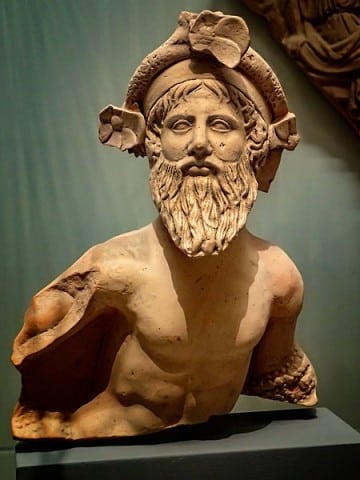
The depictions of Dionysus’ appearance have radically changed throughout the years. Dionysus was originally depicted as a more mature, bearded figure. He wore an ivy wreath and had thick, curly, dark hair that reached his shoulders. He usually held a goblet with two handles on its sides, kantharos.
However, the god’s most frequent and recent depictions show him as younger and more effeminate. He had much longer curly hair that was either so dark that it appeared purple, or he was blonde. His irises were dark brown or dark green, with some describing them as piercing blue. He had a chubby face with flushed cheeks all the time.
The god would wear a purple robe and carry a thyrsus (light ivy staff).
Dionysus’ Personality
Dionysus was regarded as Olympus’s drama king. He had a fiery and outgoing personality. As one would expect from the god of wine and feasting, Bacchus had both good and bad qualities.
He was hedonistic and carnal, as evidenced by the mysteries and sacral orgies that occurred in his honor. His entire existence demonstrates that divine ecstasy and pleasure are transcendental experiences. Sexual relationships, dance, alcohol, food, exotic music, and rituals performed under the influence of various intoxicants all point to the god’s sensual and hedonistic nature.
Dionysus was also a nonconformist in the way that only a god could be. His cult would upend ancient Greek societies’ traditional values. His names, Eleutherios in Greek and Liber in Latin, refer to how he liberates people from social norms and inhibitions.
He wasn’t all fun and games, though. Dionysus has the potential to be a chaotic and vengeful god. He had the ability to transform humans into both divine and animalistic beings. He would casually have anyone who disagreed with him go insane or even be murdered. That included not only those who directly denied him, but also those who opposed his followers, as evidenced by the brutal murder of Pentheus, see below.
Dionysus’ Powers
First and foremost, Dionysus shared all of the Olympians’ common powers. He was extremely strong and powerful, as well as immortal. He had superhuman endurance, omnipotence, and the ability to shape-shift.
Fun fact: his regular shapeshifting to a lion or a bull earned him the nickname “Bromios,” which means “the one who roars.”
Aside from that, Dionysus’ most powerful ability was the ability to drive mortals insane. He had the ability to instill ritualistic frenzy in his followers, earning him the title “liberator.” However, he had the ability to drive insane anyone who dared to disrespect him.
The god could also intoxicate people and make them see illusions.
Dionysus’ Sacred Symbols
The majority of Dionysus’ sacred symbols were animals or plants. His most well-known symbol, however, was his thyrsus. The thyrsus or thyrsos was a light vine-covered staff. A pinecone was frequently found on top of the staff. It was the god’s sacred staff, which he carried with him everywhere. It was also a common symbol in Bacchus celebrations.
Kantharos, a large goblet with two handles, was also a godly symbol.
Theatrical masks were also his symbol as the god of the theater. Finally, Bacchus was associated with anything phallic in shape. In Dionysiac festivals, phallic-shaped objects were very common.
Dionysus’ Sacred Animals / Plants
The ivy leaves and grapevine were Bacchus’ sacred plants. He and his objects were frequently covered in ivy leaves, and he wore an ivy wreath on his head. He was closely associated with the grapevine as the god of wine.
The bull, panther, and lion were his sacred animals. Dionysus was known to shapeshift into each of these animals on the spur of the moment. He also had a powerful roar, as evidenced by his nickname, Bromios (=loud).
Dionysus’ Roles and Responsibilities
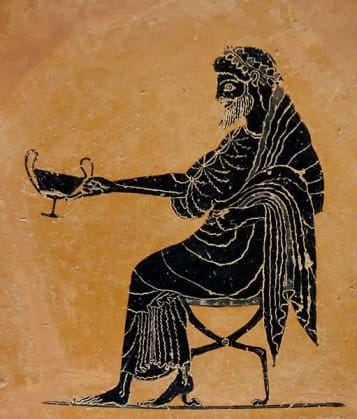
The role of Dionysus was a unique one in the Greek and Roman pantheon. Being a highly paganistic god and a lot different than the others, his role was not to keep the people in order. Au contraire – his role was to liberate them, free them from social norms.
He was, first and foremost, the god of wine, winegrowing, and winemaking. Together with the Satyrs he would travel the world in search of all the secrets of winemaking. He was in charge of vine cultivation, soil fertility, and the fermentation of grapes into wine.
Dionysus is also the god of plants in general. He was in charge of the plants’ blooming and fruit-bearing.
Bacchus was not only the god of winemaking, but also of wine drinking. He was the god of intoxication and drunkenness, of festivals and parties, of ritualistic orgies and merriment. His free spirit also made him the patron saint of choral music and the theater, two of the most performative arts.
The god’s strange, primal nature was also evident in his celebrations. According to his liberating role, he would instill frenzy in his followers and cause hallucinations. He was also the most effeminate of all gods and a known bisexual – Dionysus rites would include ritualistic orgies in which people of all genders would freely participate.
Play Dionysus’ Games
Can you match the debauchery of Dionysus? Find the words and discover!
You can also play around with dionysus’ and other Olympian gods’ names in this fun anagram game:
If you had fun playing these games, why don’t you try our other games?
Myths About Dionysus
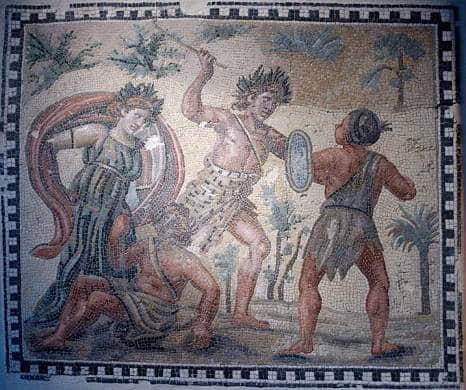
There are not so many myths about Dionysus as for the other Olympians. He did not have a big part in myths where other gods dominated, like the Trojan War, and he was more involved in personal accounts.
the wanderings of dionysus
We’ve seen how Dionysus was taken to Mount Nysa after being rescued from the body of the dead Semele and was born from Zeus’ thigh. The rain-nymphs Hyades raised him there.
When Dionysus was older, he discovered the secrets of winemaking. Hera struck him insane and sent him to roam the earth aimlessly. When he arrived in Phrygia, the goddess Cybele (identified with Rhea) discovered him and cured him.
Bacchus then traveled to Asia to learn the secrets of winemaking. He spent a significant amount of time in India in particular. Dionysus, according to Strabo, had reached the end of the earth in India. He built pillars there, which were thought to support the skies.
According to Diodorus Sicelus, the god was actually conquering the places he would visit. Except for Ethiopia and Britain, he had conquered the entire known world. It is said that on his way back from India, he founded the Temple of Ammon in Libya, which was later discovered by Alexander the Great.
The indian war
The main theme of Nonnus’ epic poem “Dionysiaca” is Dionysus’ war in India. Zeus sent Bacchus to India to gain the peoples’ worship. They clung to their ancestral gods, however. Worse than that, they even refused to consume the god’s wine.
Bacchus then began to assemble a massive army. He marched across India, picking up many lovers along the way.
Deriades, son of the river god Jhelum, was his main foe. As the son of the river god, he drank only water. Deriades fought several battles with Dionysus, with the assistance of Brahmins. Bacchus eventually triumphed and returned home victorious.
Pentheus and the daughters of Cadmus
When Dionysus triumphantly returned to Greece, he attempted to instill his reverence. Many rulers, however, opposed him because they were afraid of the exotic and primal way the God was venerated.
Euripides describes one famous example in his magnificent play “The Bacchae.” Bacchus returns to Thebes, which is now ruled by King Pentheus, the god’s cousin. Pentheus, his mother Agave, and his aunts Autonoe and Ino all denounce the god. It should be noted that the women were Cadmus’ daughters, who had previously been cursed for killing a sacred drakon.
Dionysus was enraged by the denunciation of his reverence. Pentheus was driven insane by the god and forced to witness the ecstatic rituals of Dionysus’ female followers, the Maenads. Of course, no man was allowed to observe the ritual.
The Maenads spotted him and, in a divine frenzy, tore him apart with their own hands, limb by limb – a practice known as “sparagmos.” Not only that, but Agave, Ino, and Autonoe were present – Agave even mounted her son’s head on a pike and marched it to Cadmus!
Dionysus then appeared and punished Agave and her sisters, as well as Cadmus and his wife.
Midas’ Touch
A lesser myth but widely loved is the one of the Phrygian king Midas. Midas had rescued Dionysus’ master, Silenus, while he was walking around drunk.
Dionysus presented Midas with a reward of his choosing. Midas, greedy, demanded that everything he touched turn to gold. Dionysus was dissatisfied with his decision, but he granted his wish.
Midas was overjoyed when every object he touched turned to gold. His joy, however, was fleeting. After turning his food and, eventually, his daughter to gold, he realized how foolish his decision had been.
Midas begged the god to save him because he couldn’t even eat and was dying of starvation. Dionysus agreed to assist the king and instructed him to bathe in the Pactolus River. Midas was saved, and the river’s sands turned to gold.
Dionysus in Ancient Greek Religion
What Dionysus was most famous for was actually the festivals and rituals held in his honor, as we have already seen in the case of the Maenads.
Sites Sacred to Dionysus
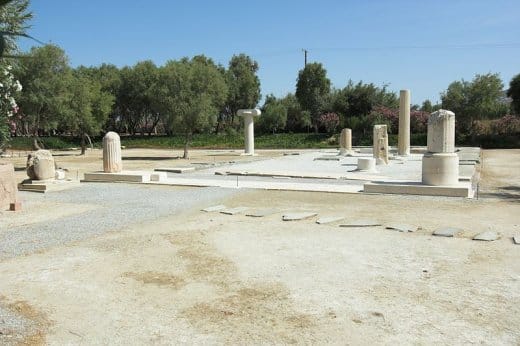
There aren’t many temples to Dionysus still holding up to this day. The island of Naxos was a sanctuary to the god. The Temple of Dionysus in Naxos was one of the cult centers of the god. There was also the Theater of Dionysus in Athens, as a part of the sanctuary for Dionysus Eleuthereus.
There were also temples of Bacchus in Delos, Thebes, Teos, and Al-biqā in Lebanon.
Worship & Festivals
There were numerous Dionysus festivals. The most well-known was the Dionysia, one of the oldest winter festivals held in Attica. Drama performances and competitions were held. The attendees would carry wooden phalluses, bread, water, and wine. The Anthesteria was another festival that was held in the spring.
The Dionysian Mysteries, on the other hand, were the most important aspect of Dionysus’ cult. In ancient Rome and Greece, they were rituals based on intoxication and other techniques to induce a trance-like state. They were also welcoming to society’s marginalized people, such as slaves, non-citizens, and outlaws. The final step of the mysteries was transcendental.
The lack of information about the Dionysian cult has piqued people’s interest and created a shroud of mystery around the cult and the rites.
Representations of Dionysus in Art
Dionysus was frequently depicted with his thiasos, his band of Satyrs and Nymphs. Later, he was depicted with his frenzied followers, the maenads. Dionysus can be seen in the Parthenon sculpture, or as an infant in Hermes’ hands in Praxiteles’ famous sculpture. A newer depiction of the god can be found in Caravaggio’s painting “Bacchus” (1956).
In The Old Texts
Bacchus appears frequently in ancient theatrical plays. Aside from Homer and Hesiod, who discussed each god in the Greek pantheon, Bacchus appears everywhere. His appearance is prominent in Aristophanes’ The Frogs and Euripides’ The Bacchae.
Nonnus also wrote an entire epic poem about Dionysus and his travels in India. Ovid has also written extensively about Dionysus’ love interests.
FAQs
Dionysus was the God of Wine and Grape Harvest, of Festivities and Merriment, the God of Divine Ecstasy and Frenzy, and of the Theater.
Zeus and Semele.
Dionysus is similar to Freyr and/or Odr.
The Satyrs and a lot of nymphs, also the Maenads.
Dionysus was an Olympian, even though some versions of Greek mythology include Hestia as the 12th Olympian, and exclude Dionysus.
Sources
Featured Image Credit: Dosseman, CC BY-SA 4.0, via Wikimedia Commons

